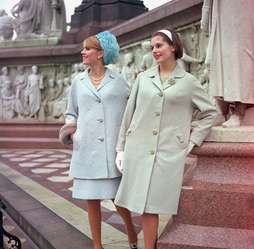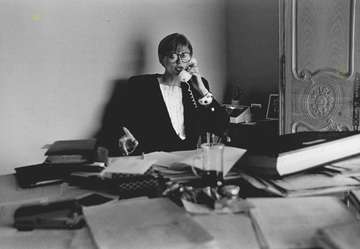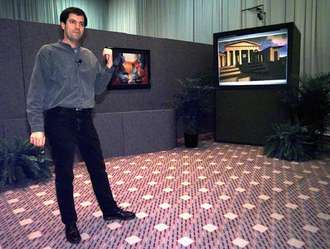Workwear / Global
The New York Wardrobe
The rise of trainers and hoodies as acceptable clothing for the workplace, in the West at least, has seen sales of suits and ties decline. But is the blurring of workwear and casual wear necessarily a good thing?
Scott Birnbaum is the founder of New York-based venture-capital firm Red Sea Ventures and he’s betting his money on the shift in how we dress for work. Two of Red Sea’s successful investments are in Allbirds and Outdoor Voices, known, respectively, for a Merino-wool shoe-slipper hybrid (that has become the darling of Silicon Valley) and matte athleisure. “The boundaries between personal and work life have become so blurred, they’re almost invisible,” says Birnbaum on the phone from Manhattan. “As a result we’ve normalised the concept of casual wear across all environments.”
When it comes to work, those environments now include the traditional office but also hotel lobbies, cafés, the park and, for me on this call, a kitchen table at home in Japan at 23.00. I’m wearing pyjamas and Birnbaum is none the wiser. Not that he’d care. “Thanks to the internet, a lot of meeting time and relationship work can be done by email, phone and video conference,” he says. “That frees you to dress to make yourself happy and not necessarily anyone else.”
The “computer geeks” (AKA founders) of the first dot-com boom are credited (or blamed) for ushering in a relaxed approach to workwear. It was their adoption of khakis that shamed white-shoe financiers into embracing the concept of “casual Fridays”. The trend has picked up again as the second dot-com boom (led by social media and e-commerce) reverberates around the world.
Over the past five years the United States Society for Human Resource Management has found an 18 per cent spike in employers who permit casualwear any day of the week. In a 2018 survey by the workplace research firm XpertHR, of 477 employers in the UK across all sectors, 89 per cent said a short-sleeved shirt was acceptable – and more than half thought the same of jeans and T-shirts. Meanwhile relaxing dress codes in the western world has led to a noticeable decline in the sale of neckties over the decade, according to data from American market research firm IbisWorld; the firm has also tracked the demise of dry-cleaning shops for the same reason.
Despite the many reports of trainers in C-suites, especially in the technology industry, there’s another story to be told: in many sectors, norms haven’t changed all that much. Laura Thomas, a Sydney barrister, wears much the same thing from Monday to Friday. “My billable rate is hundreds of dollars an hour, thousands of dollars a day,” she says. “I have to look like I get paid this much money so I wear suits.” Women in finance and government also say that they wear a dress or trousers with a jacket and heels every day – and that they find plenty of ways to express themselves. Elizabeth Broderick, who was the Australian sex-discrimination commissioner from 2007 to 2015, says there’s more choice in suiting than ever. “When I think about my life as a junior lawyer in the 1980s, it was very much a case of women dressing to say, ‘We’ve arrived,’” she says. That meant power colours and padded shoulders. She loves that the look has softened. “There’s a lot more feminine energy now.” This idea is echoed elsewhere: in Thailand, for instance, female executives are known for wearing polished, ultra-feminine ensembles.










Of course, ever-proliferating options can also lead to anxiety. In March of this year, Goldman Sachs (following other corporate giants such as JP Morgan) announced that it was relaxing its dress code for all employees. Yet its company-wide memo was slightly cryptic: it said that employees must dress “in a manner that is consistent” with client expectations, which does not always mean casual gear, and must “exercise good judgment” in determining what is an appropriate wardrobe (which just seems to be piling pressure on employees to demonstrate their grasp of a particular work occasion through their clothes).
Facebook, meanwhile, with its hoodie-wearing CEO, doesn’t have a code at all – or at least, not officially. Unofficially it definitely does have a uniform: Allbirds trainers, white T-shirts (likely from a brand such as Everlane) and jeans. You could even argue that the informal tech-bro uniform is just as prescriptive as suits once were for bankers; casual should not be confused with flexible.
Dina Scherer, the owner of Modnitsa Styling, a New York-based styling company, says that the casualisation of work dress-codes “can be both good and bad”. Scherer generally advises female clients, many in creative fields, to assemble a work wardrobe that is “a more elegant version of their weekend one”. Still, she concedes that “creating a wardrobe that’s equal parts appropriate and put-together is becoming a challenge”.
For men the corporate uniform is no longer a given. Italian tailoring brands such as Boglioli, Orazio Luciano and Barena have built their businesses on the sort of unstructured blazers that young CEOs can throw over a T-shirt. Marco Pagani, creative director at Neapolitan tailor Orazio Luciano, told us that there has been a big change since 2010: now his brand sells far more individual blazers than full suits. Meanwhile, at the recent shows in Milan, Italy’s king of luxury menswear, Ermenegildo Zegna, presented a suit that could be broken down into different permutations with varying degrees of formality. The designer, Alessandro Sartori, said his intention was “to give people who have never worn tailoring a reason to”.
The late, great fashion historian Anne Hollander predicted this when she wrote that the suit runs contrary to “current millennial impulses tend[ing] towards disintegration, in style as in politics”. The suit is, she argued in Sex and Suits: The Evolution of Modern Dress, “neither postmodern nor minimalist; multicultural nor confessional”.
Perhaps because the suit is none of these things, it’s an item of clothing that has proven tenacious in parts of northeast Asia, where conformity with the group is often prized. The Japanese office worker’s uniform of navy suit and a white shirt is still so ubiquitous – and so inextricably associated with high status, white-collar work – that last year a Tokyo-based plumbing firm introduced a lightweight, quick-drying uniform that looks exactly like a business suit, all to attract more employees. “After our engineers wore the workwear for a year, we received a number of young applicants,” the firm’s spokesman told the Japan Times.
The insistence on suits in all work contexts can even be a health hazard. In 2005 the Japanese government launched the Cool Biz campaign, which allowed its bureaucrats to work without ties and jackets on hot summer days. Japanese women, too, pay a price for rigid dress codes. Yumi Ishikawa made headlines in June when she submitted a petition to the Japanese Labour Ministry with more than 18,000 signatures, demanding the government ban edicts from employers requiring women to wear high heels to work. Ishikawa, who worked at a funeral home in Tokyo, was tired of standing for hours each day in the black heels required by her employer. This kind of rule is not unusual in Japan but the pain, which radiated up Ishikawa’s calves while her male colleagues strode around in brogues, spurred her to action. Although the government has not yet announced any reform, the movement Ishikawa started on Twitter, #kutoo (a portmanteau of the Japanese words for shoes, kutsu, and pain, kutsuu) continues.
The conservatism of Japanese women’s workwear is reflective of the structural barriers they face: Japan is ranked 110th among 149 in the World Economic Forum’s 2018 gender-equality rankings. But another reason for the prevalence of formal clothing might be that the gig economy is yet to take over in the way it has in the West. Japan is known for its tradition of lifelong employment, reinforced recently by an extreme labour shortage as its population ages. By contrast a 2018 Gallup study in the US revealed that 29 per cent of all workers there are in an “alternative work arrangement” as their primary job. Including multiple job holders, 36 per cent have a gig work arrangement “in some capacity”. This amounts to about 57 million Americans.
Flexibility and freedom are often touted as benefits of independent work, along with the ability to wear whatever we please. When Birnbaum talks about “dressing to make yourself happy”, that sounds good. But when he says that the rise of athleisure in professional settings is partly because of our neverending workload and the need to “prioritise movement at any time”, it starts to sound a tad dystopian. Tailored dresses and buttoned-up jackets serve a valuable purpose: they delineate, physically and mentally, between work life and life-life.
As for men, they may be done with ties but Don Draper in a Patagonia fleece doesn’t have quite the same cachet. A sharply-tailored ensemble – a suit or separates – exudes professionalism. Yet time will tell whether yoga pants moisture-wick their way to sartorial supremacy. “We are going to see an emergence of a new style paradigm,” says Birnbaum. He adds that as it becomes even more popular, easy-wear clothing will become more elegant and “the idea will not be comfort at all costs but a better integration of comfort and style”. As he says this, your writer looks down at her bathrobe. It’s not stylish. But the fact that it can be worn to work, assuming the internet connection complies? That suits just fine.
MONOCLE COMMENT: We’re all for making an effort when dressing for work. That doesn’t have to mean going formal (although a sharp suit can give you a shot of confidence). A smart blazer and tailored trousers show you mean business. We’re not ready for office hoodies just yet.


